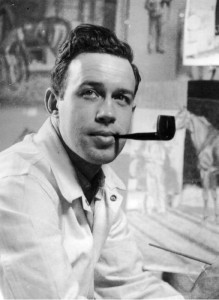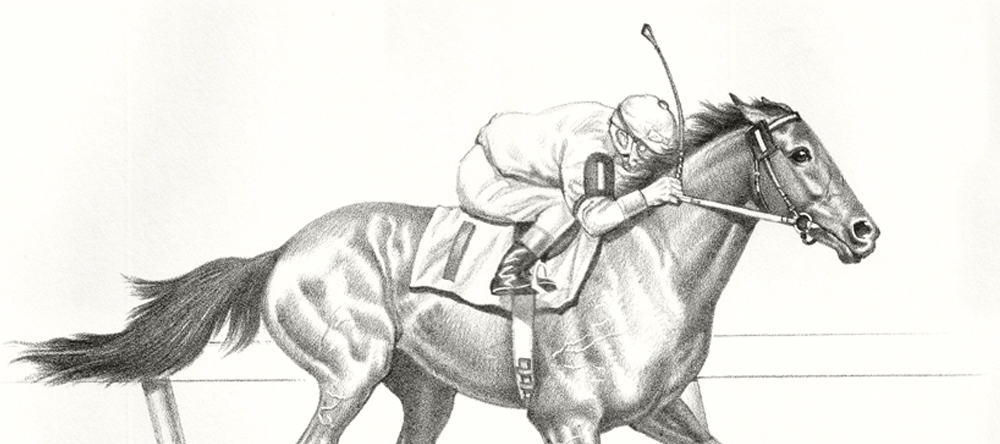 The Artist Allen F. Brewer, Jr.
The Artist Allen F. Brewer, Jr.
BY FRANK TALMAGE PHELPS
One of the world’s foremost equine artists, Allen F. Brewer, Jr. had won the praise alike of critics, horsemen and the general public for his oils, watercolors and drawings.
The critics rated his work highly in such technical factors as skilled composition, perspective, handling of light and shadow, and ability to suggest by external appearance the underlying structure of bone and muscle. Horsemen admire his art for his ability to reproduce an exact likeness of a particular horse. And the general public, without worrying over technicalities or likenesses, just plain enjoys his pictures.
Born in Newton Center, Mass., Allen brewer spent his early youth in Texas, the land of cowboys, cutting horses and Quarter Horses. This atmosphere would fascinate any growing lad; but in Allen’s case the fascination was demonstrated in a special way. At every opportunity he would sketch the horses and scenes around him. Although his family soon moved to New Jersey, he never forgot his Texas interlude. Even today he sports the sting tie, Texas boots, and 10-gallon hat and easy informality characteristic of the Southwest.
Nor did he forget horses and art. He went on to Yale University’s school of Fine Arts, where he completed the six-year course in four years to receive a B.F.A. degree. He won no “solemn “grind”, though, for he played football, baseball, tennis and naturally-since it involved horses-polo. He also spent long hours at the ROTC stables, riding and sketching. And, in order to learn equine anatomy, he dissected a horse, making over 1,000 studies of the bone and muscle structure.
It is typical of Allen’s tremendous energy that he found time to do all this while working his way through college by selling his fellow students trick pin-up paintings. The trick came into play when a student’s parents came visiting; the student simply flipped the picture over, and the nude was replaced by an innocuous landscape for the benefit of the home folks.
Upon graduation in 1942, Allen waived a 2nd Lieutenant’s commission in the Calvary (then mechanized), and enlisted in an Engineer Camouflage Battalion, where he put to good use his artistic training. After a year he transferred to the Air Corps, where he worked on highly secret picture charts, laid out manuals and instructions books, and even painted murals for the high command.
In his spare time he did portraits of many of his fellow servicemen, their wives and children-some 400 in all, and for his own pleasure he also drew some of the best Thoroughbreds running at that time, like Count Fleet and Whirlaway. During this period he won numerous military art awards. Discharged from military service in February 1946. He and two partners set up an advertising agency in Orlando, and acquired several large accounts for national advertisers.
He was also a frequent visitor at the harness tracks near Orlando, where he received from Gibson White his first major equine commission for a painting of the winter-book favorite for the 1946 Hambletonian, Deanna, with 73-year old driver Ben White.
But Allen’s prime interest lay in the Thoroughbred field, and he moved back to New Jersey, where he could pursue this interest more closely. Establishing a studio; he secured contracts to do the artwork for programs and advertising of Belmont Park, Monmouth Park, Freehold Raceway and other commercial accounts. He also did the artwork on booklets published by the Thoroughbred Racing Association and horse farm brochures, etc.
His first major Thoroughbred painting commissions came from the late William G. Helis, Sr.; and it was Allen’s award-winning work at the Helis Farm that first brought him to the attention of horsemen throughout the country.
In 1947 he moved to Lexington, Ky., the heart of the traditional Blue Grass “horse country”; and bought a small farm.
The list of famous horses he has painted, and the noted homes and offices where his work hangs, would be almost endless. Suffice it is to say that he has “done” nearly all the most noted racehorses, stallions and brood mares of his day; and his art graces the walls of practically all the large breeding-farm offices and stable owners’ homes. In addition, his work is widely published in national and international magazines; and reproduced on calendars, fabric, Christmas cards, playing cards, serving trays, chinaware and even privately commissioned wallpaper.
He maintained advertising accounts for a number of Thoroughbred breeders, stallion owners, racetracks, sales organizations and other horse-associated businesses.
Meticulous study went into each equine portrait he painted. Although he had a remarkable memory for the characteristics individually of a horse, even down to the pattern of veins and definition of tendons, he did not depend on memory alone. Countless sketches, water colors, still photographs and even color movies (and incidentally Allen had become one of the best equine photographers in the country) were made before the final canvas is begun.
His favorite technique, tracing to the 15th-century Florentine school, involves the use of an egg-tempera base, which is first covered with a series of transparent color glazes, then built up with an opaque color in the light areas. This is not only one of the most permanent painting methods known, but it also gives a three-dimensional effect.
Not only did he paint horses, but he also owned and drove them. He was one of two men who had both a trainers license for Thoroughbreds and a trainers and drivers license for harness horses. He was a past president of the Gentlemen’s Driving Club of Lexington, president of the Lexington Advertising Club, Florida Breeders Assn., California Thoroughbred Breeders Assn., and an active harness driver. He owned Standardbred mares and Thoroughbred mares and because of his thorough knowledge of the horse and conformation, numerous owners had commissioned him to select and buy yearlings and mares for them.
Brewer was an avid art collector in his own right and owned or was a partner in many outstanding equine paintings, such as: originals by Munnings, Stull, Cross, Lucas, etc.
